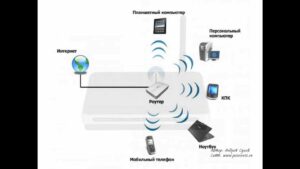- Checking the connection and network settings
- How to check your Wi-Fi connection?
- How do I change DNS settings on my computer?
- Rebooting devices and equipment
- How to reboot the router?
- How to restart your computer?
- Using the command line to solve problems
- How to use the ipconfig command?
- Contact your internet service provider
- How to submit a request for equipment repair?
Checking the connection and network settings
The first step in resolving network inability issues is to check your network connection and settings. First, check if your computer is connected to the network. If you are using a wireless connection, make sure you are connected to the correct access point and that your network card is turned on. If you are connected to a network, check your network settings. Open Control Panel and select 'Network and Internet'. Then select 'Network and Sharing Center' and right-click on your connection. Select 'Properties' and make sure all network settings are configured correctly. It's also worth checking for updates for your network card. Open Device Manager and find your network card. Right-click on it and select 'Update Driver'. If an update is available, install it. If you still can't connect to the network, try restarting your router and modem. Sometimes a simple reboot can solve the network connection problem. All these steps will help you check your network connection and settings, which may lead to solving the network connection problem. If these steps do not help, then the next step is to more thoroughly diagnose the problem.
How to check your Wi-Fi connection?
Before you begin to fix the lack of network access, you need to make sure that you are actually connected to Wi-Fi. To do this, you can do the following:
1. Make sure Wi-Fi is turned on on your device. This can usually be done through the device settings or Wi-Fi control panel.
2. Establish a connection to a Wi-Fi router. To do this, you need to select a Wi-Fi network from the list of available networks and enter a password if required.
3. Open any browser and try to load any page. If the page loads successfully, then the Wi-Fi connection is working correctly.
If problems occur when performing these steps, then there may be problems with the settings of the Wi-Fi router or device. In this case, it is necessary to carry out additional diagnostics and correct the problem.
How do I change DNS settings on my computer?
If you are having problems accessing the network, it may be due to incorrect DNS settings. DNS (Domain Name System) is a system that translates domain names into IP addresses needed to connect to a server. If DNS is not working correctly, then network access will be limited.
To change DNS settings on your computer, you need to follow these steps:
1. Open Control Panel and select 'Network and Internet'.
2. Click on 'Network and Sharing Center'.
3. Select 'Change adapter settings'.
4. Find the connection you are using to connect to the Internet and right-click.
5. Select 'Properties'.
6. Select 'Protocol Version 4 (TCP/IPv4)' and click on 'Properties'.
7. In the 'General' section, select 'Use the following DNS server addresses'.
8. Enter the addresses of the DNS servers you want to use. These are usually addresses provided by your ISP, but you can use other DNS servers, such as Google Public DNS (8.
8.
8.
8 and 8.
8.
4.
4).
9. Click 'OK' and close all windows.
After this, you must restart your computer for the changes to take effect. If the problem was due to incorrect DNS settings, then after performing these steps, network access should be restored.
Rebooting devices and equipment
One of the easiest and most common ways to fix a lack of network access is to reboot all devices and equipment that are connected to your network. This includes your computer, router, modem, and other devices that may be connected to your network.
Rebooting your devices helps clear caches and resolve errors that may be causing network connectivity issues. Additionally, it can help to update settings on devices and equipment, which can help improve connectivity.
To reboot your devices, simply turn them off for a few seconds and then turn them back on. Usually, 30 seconds is enough for this. Remember to start with the modem, then the router, and then move on to other devices on your network.
After the devices have rebooted, try connecting to the network again to make sure the problem is resolved. If the problem persists, you may need to contact a technician or Internet service provider.
How to reboot the router?
If you are faced with the problem of lack of network access, then the first step you can take is to reboot the router. This can help restore network functionality and resolve some internet connection issues.
In order to reboot the router, you need to perform the following steps:
1. Disconnect the router from the electrical network.
2. Wait a few seconds for the router to turn off completely.
3. Connect the router back to the electrical outlet and turn it on.
4. Wait until the router starts up and connects to the Internet.
After completing these steps, you should have access to the network. If the problem persists, there may be another problem. In this case, it is better to contact specialists who will help find and eliminate the cause of the problem.
How to restart your computer?
Restarting your computer can help resolve many issues, including being unable to access the network. To restart your computer, click on the 'Start' button in the lower left corner of the screen and select 'Restart'. Or, you can press the 'Ctrl + Alt + Delete' key combination on your keyboard and select 'Restart' from the menu. After restarting your computer, try connecting to the network again. If the problem is not resolved, try checking your network settings and contact a specialist.
Using the command line to solve problems
When you have problems accessing the network, sometimes using a GUI may not be effective. In such cases, using the command line may be a more efficient solution.
First, you need to open the command line. This can be done by pressing the 'Win+R' key and entering 'cmd' in the search bar. Next, you need to enter the 'ipconfig' command to obtain information about the IP address configuration and network connections.
If you are unable to connect to the network, you can try rebooting your router. To do this, enter the command 'ipconfig /release' to release the IP address and 'ipconfig /renew' to obtain a new IP address.
If this doesn't solve the problem, you can try resetting your TCP/IP settings. To do this, enter the command 'netsh int ip reset' and restart the computer.
If all the above methods do not help, you can try changing the DNS server. Enter the command 'ipconfig /all' to get information about your current DNS server. Then, enter the command 'netsh interface ipv4 set dns name='Local Area Connection' static 8.
8.
8.
8′ to change the DNS server to 8.
8.
8.
8. This is Google's DNS server and is often used as an alternative.
Using the command line can be an effective way to resolve network access problems. If you are not confident in your skills, you can always turn to professionals for help.
How to use the ipconfig command?
The ipconfig command is a tool that allows you to view information about network connections on your computer. It can be useful when configuring network settings or troubleshooting network connection issues.
To use the ipconfig command, open a command prompt on your computer. To do this, press the Win + R key combination on your keyboard and enter the cmd command. Press Enter and a Command Prompt window will open.
To view information about network connections, enter the ipconfig command and press Enter. As a result, information about network adapters, IP addresses, gateways, DNS servers and other network connection parameters will appear on the screen.
If you want to get more detailed information about your network connection, you can use the ipconfig command parameters. For example, if you need to find out the IP address and subnet mask for a specific network adapter, you can run the ipconfig /all command.
As you can see, the ipconfig command is a useful tool for working with network connections on a computer. It can help you quickly identify network connection problems and adjust network settings for more stable operation. If you are having trouble accessing the network, rebooting your network adapter may help. This can be done via the command line. Here's how to do it:
1. Open a command prompt. To do this, click on the 'Start' button and enter 'cmd' into the search bar. Then click on the Command Prompt icon to open it.
2. Enter the command 'ipconfig /release' and press 'Enter'. This command will disable all network adapters on your computer.
3. Enter the command 'ipconfig /renew' and press 'Enter'. This command will enable all network adapters and try to obtain a new IP address.
4. Wait a few seconds for the reboot process to complete. Then try connecting to the network again.
If restarting the network adapter doesn't help, the problem may be elsewhere. Try rebooting the router or contact a specialist for help.
Contact your internet service provider
If you are having problems accessing the network, the first step is to contact your Internet service provider. He will be able to find out the cause of the problem and help fix it.
When contacting your provider, you need to have on hand information about your tariff plan and equipment connected to the network. It is also useful to describe the problem in as much detail as possible, indicating the time it occurred, as well as possible additional factors that may affect the quality of the connection.
The provider may offer a number of solutions, including rebooting the equipment, adjusting network parameters, or diagnosing the communication line. In case of complex problems, the provider may send a specialist to carry out additional work.
It is important to remember that Internet service providers strive to provide the best possible connection quality, and therefore it is recommended to work with them to find a solution to the problem. One of the first things to do if you encounter a problem with no network access is to contact your ISP's technical support. The technical support phone number is usually listed on the provider's website or on the back of your invoice. You can also try contacting support via live chat or email. When contacting technical support, be prepared to provide your credentials and describe the problem in as much detail as possible. Your provider's technicians can help you diagnose the problem and provide instructions on how to resolve it. If the problem is hardware related, the provider may offer to send a technician to repair or replace the equipment.
How to submit a request for equipment repair?
If you have a problem with your equipment and it needs repair, then the most important thing is to submit a repair request. To do this, you need to contact the IT technical support department of the company where you work.
The application must provide the following information:
— The name of the equipment that requires repair;
— A detailed description of the problem;
— The number or name of the room where the equipment is located;
— Contact information to contact you.
After you have submitted a request, an IT technical support specialist will contact you to clarify the details and schedule a repair time.
Please remember that equipment repairs should only be carried out by qualified personnel. Therefore, unless you are a professional in this field, do not try to fix the problem yourself. This can lead to even more serious consequences.
Read further:






